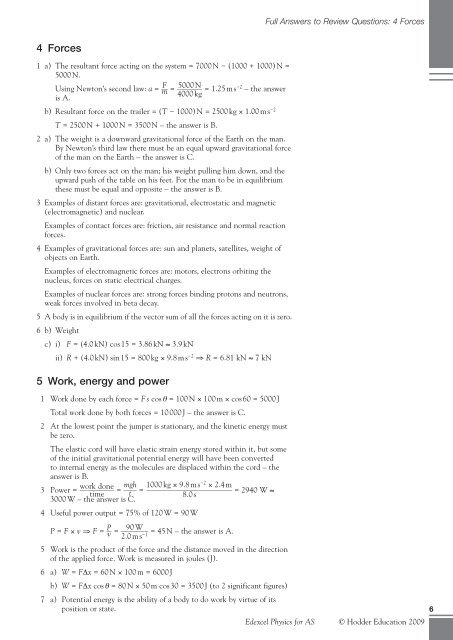Full Answers to Review Questions - Hodder Plus Home
Full Answers to Review Questions - Hodder Plus Home
Full Answers to Review Questions - Hodder Plus Home
You also want an ePaper? Increase the reach of your titles
YUMPU automatically turns print PDFs into web optimized ePapers that Google loves.
4 Forces<br />
1 a) The resultant force acting on the system = 7000 N − (1000 + 1000) N =<br />
5000 N.<br />
Using New<strong>to</strong>n’s second law: a = F __<br />
m = _______ 5000 N<br />
4000 kg = 1.25 m s−2 – the answer<br />
is A.<br />
b) Resultant force on the trailer = (T − 1000) N = 2500 kg × 1.00 m s −2<br />
T = 2500 N + 1000 N = 3500 N – the answer is B.<br />
2 a) The weight is a downward gravitational force of the Earth on the man.<br />
By New<strong>to</strong>n’s third law there must be an equal upward gravitational force<br />
of the man on the Earth – the answer is C.<br />
b) Only two forces act on the man; his weight pulling him down, and the<br />
upward push of the table on his feet. For the man <strong>to</strong> be in equilibrium<br />
these must be equal and opposite – the answer is B.<br />
3 Examples of distant forces are: gravitational, electrostatic and magnetic<br />
(electromagnetic) and nuclear.<br />
Examples of contact forces are: friction, air resistance and normal reaction<br />
forces.<br />
4 Examples of gravitational forces are: sun and planets, satellites, weight of<br />
objects on Earth.<br />
Examples of electromagnetic forces are: mo<strong>to</strong>rs, electrons orbiting the<br />
nucleus, forces on static electrical charges.<br />
Examples of nuclear forces are: strong forces binding pro<strong>to</strong>ns and neutrons,<br />
weak forces involved in beta decay.<br />
5 A body is in equilibrium if the vec<strong>to</strong>r sum of all the forces acting on it is zero.<br />
6 b) Weight<br />
c) i) F = (4.0 kN) cos 15 = 3.86 kN ≈ 3.9 kN<br />
ii) R + (4.0 kN) sin 15 = 800 kg × 9.8 m s −2 ⇒ R = 6.81 kN ≈ 7 kN<br />
5 Work, energy and power<br />
1 Work done by each force = F s cos θ = 100 N × 100 m × cos 60 = 5000 J<br />
Total work done by both forces = 10 000 J – the answer is C.<br />
2 At the lowest point the jumper is stationary, and the kinetic energy must<br />
be zero.<br />
The elastic cord will have elastic strain energy s<strong>to</strong>red within it, but some<br />
of the initial gravitational potential energy will have been converted<br />
<strong>to</strong> internal energy as the molecules are displaced within the cord – the<br />
answer is B.<br />
3 Power = _________ work done mgh<br />
time<br />
= ____<br />
t = 1000 kg × 9.8 m s−2 ______________________ × 2.4 m<br />
= 2940 W ≈<br />
8.0 s<br />
3000 W – the answer is C.<br />
4 Useful power output = 75% of 120 W = 90 W<br />
P = F × v ⇒ F = P __<br />
v = _______ 90 W<br />
2.0 m s−1 = 45 N – the answer is A.<br />
5 Work is the product of the force and the distance moved in the direction<br />
of the applied force. Work is measured in joules (J).<br />
6 a) W = F∆x = 60 N × 100 m = 6000 J<br />
b) W = F∆x cos θ = 80 N × 50 m cos 30 = 3500 J (<strong>to</strong> 2 significant figures)<br />
7 a) Potential energy is the ability of a body <strong>to</strong> do work by virtue of its<br />
position or state.<br />
<strong>Full</strong> <strong>Answers</strong> <strong>to</strong> <strong>Review</strong> <strong>Questions</strong>: 4 Forces<br />
Edexcel Physics for AS © <strong>Hodder</strong> Education 2009<br />
6

















